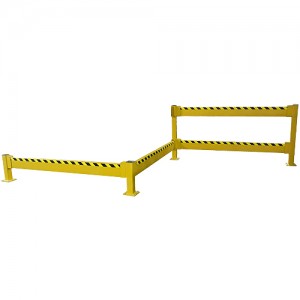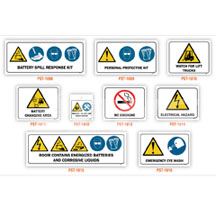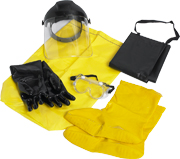We use cookies to make your experience better. To comply with the new e-Privacy directive, we need to ask for your consent to set the cookies. Learn more.
Best Safety Practices for Forklift Battery Charging and Handling
Industrial battery safety doesn't need to be complicated. These battery charging safety tips should help you create an effective strategy for your operation.
As with any industrial operation involving heavy equipment, safety is a major priority when charging batteries and utilizing forklift battery changers. If adequate safety precautions aren’t in place, personnel can face the danger of severe injury or death. According to OSHA, the battery changing process presents hazards involving four characteristics of the standard lead-acid forklift battery:
-
Weight:
Lift truck batteries are extremely heavy, and crushing risk is always a factor when batteries are suspended by battery handling equipment.
-
Caustic Fluids:
The electrolytes found in lead-acid battery cells include large volumes of sulfuric acid, which can cause serious chemical burns on contact with skin.
-
Dangerous Gasses:
During the charging process, batteries emit hydrogen gas that can cause flames or explosions if it is allowed to build to excessive levels.
-
Exposure to Electricity:
Active battery cells hold an electrical charge which can short circuit if a worker touches them. This can cause serious electrical burns, and arcing increases the risk of explosion dramatically.
Responsible operations will have detailed safety protocols available -- staff should always follow the recommended procedure, and when in doubt, ask a supervisor for guidance. With that said, here are some of the industry's standard safety recommendations when changing forklift batteries.

Figure 1. BHS Structural Barrier Rail (SBR) is a heavy-duty guard rail system used to protect the forklift battery changing area, personnel walkway, racking and shelving, and much more.
Building a Better Battery Room
Safety begins with a properly equipped battery charging area.
OSHA regulations require all battery charging tasks to take place in a specifically designated area, often called the battery room. Regardless of whether this area is an enclosed space, it needs to be separated from general traffic and appropriately ventilated so that fumes and gases generated in the charging process don't accumulate to dangerous levels.
When designing aisles and thoroughfares, keep the size of the lift trucks in mind. Protect all battery handling equipment from collisions by surrounding them with highly visible structural barriers. Battery room floors should also be level, flat and acid-resistant. For more information on flooring, see the BHS battery room floor specifications or download the informational PDF.
Floor Specifications
Download Battery Room Floors PDF.
Areas surrounding forklift battery chargers require specific safety equipment to mitigate damage in the event of a spill, splash or other accident. The following items are recommended safety equipment for battery charging rooms:

Figure 2. Improve safety, notify personnel of hidden dangers, and prevent accidents in the workplace with the BHS Signage and Posting Kit (SP-1).
- Battery Wash Stations
- Adequate Ventilation
- Battery Spill Kits
- Eye Wash Stations
- Hydrogen Gas Detectors
Battery rooms should have access to plenty of water for neutralizing electrolyte spills and flushing burns. Facilities with large fleets should keep a plumbed drench shower along with their eye wash and safety stations. Keep stores of soda ash, baking soda or other neutralizing materials within easy reach, and always include CO2, dry chemical or foam fire extinguishers.
Eliminate any potential source of ignition that could endanger your equipment. Signs that remind staff there is absolutely no smoking in the battery room should be posted, along with all the relevant warnings. With adequate safety equipment and signage, staff will have all the tools they need to keep the workplace safe and productive. To learn more about establishing a safer battery room, read the BHS guide to best practices.
Safety During the Charging Process
The single most powerful safety tool facility managers have at their disposal is proper training. Well-trained, knowledgeable staff have fewer accidents, and if something does go wrong, an actionable plan is already in place. Only trained personnel should handle battery charging equipment or forklift battery changers, and everyone assigned to charging tasks should be well-versed in accident prevention and emergency management.
OSHA recommends the following practices to keep charging tasks safe throughout the charging cycle.
- Wear the right personal protective equipment. This includes safety goggles, face shields, rubber or neoprene gloves and aprons.
- Remove metal jewelry. Anything metallic, from tools to earrings, must be kept away from uncovered batteries in order to prevent sparking.
- Take precautions with flammable materials. Never allow sparks, open flames or electric arcs to occur in the battery room.
- Check electrolyte and water levels before beginning active charging, but don’t add water - this should be done after charging is complete.
- When mixing the electrolyte, always pour acid into water, not the other way around; pour slowly.
- Keep the charger turned off and unplugged while attaching or detaching clamp connections.
- For batteries with sealed vents, don't exceed 25 amperes of current.
- When attaching clamps, start by connecting the positive clamp to the positive terminal. Connect the negative clamp and terminal second.
- If the battery heats up, or if vents start leaking fluid, turn off the charger and start over at with a lower rate of charge.
- Keep water levels at the indicated height, but only add water after recharging is complete. Use deionized water.
- Record all levels in a designated service log.

Figure 3. Wearing the items in the BHS Personal Protective Kit (PK-1200) provides added safety while watering and changing batteries, as well as cleaning and neutralizing battery acid spills.
These recommendations and requirements are not exhaustive; staff should consult manufacturer recommendations and company safety procedures to ensure the safest possible working environment. Most importantly, training programs should include detailed information on possible hazards, and only staff members who have been adequately trained should be allowed inside the battery room.
Using Battery Handling Equipment Safely
As with charging tasks, staff training is the key to safe battery changes, but proper battery handling equipment is equally important for a safe operation. Different fleets require different forklift battery changers, and matching the equipment to the vehicle is crucial. Battery lifting beams and hoists may also be part of the complete battery handling system; follow manufacturer recommendations to achieve the safest combination of equipment.
When removing batteries from trucks for charging or maintenance, these guidelines can help to prevent injury or equipment damage:
- Never try to lift batteries without proper equipment.
- Make sure the lift truck is positioned properly in relation to the forklift battery changer.
- Before the changing operation, keep the truck stable by applying brakes.
- Hooks and chains can damage batteries. Instead, use a designated forklift battery extractor system.
- If a fleet isn’t configured for side extraction, use a lifting beam or other approved lifting devices.
To move batteries across a facility, always employ a battery transfer cart or similar equipment. Transfer carts should include a roller surface for easy loading and unloading, and floor locks should be available to keep the cart from rolling on its own. Trained staff can also use gantry cranes to assist with lifting and positioning batteries.
When using forklift battery changers and related equipment, staff should follow all of the facility’s in-house safety procedures and all OSHA and state regulations. Operations are required to offer supplementary training programs to keep all personnel up to date on the latest best practices for safe material management.
Safety Depends on Equipment, Training and Compliance
Keeping battery handling systems well-maintained is necessary to prevent equipment failure, which can lead to injuries and costly damage. All charger stands, racks and charger wall brackets should be inspected and maintained on a strict schedule. Only staff who have been trained in equipment maintenance should be assigned to these tasks.
It’s difficult to overstress the importance of formal training programs for staff who engage in battery handling and charging tasks. In fact, training is mandated by OSHA 1910.178, Powered Industrial Trucks, which calls for ongoing annual training in addition to initial and periodic programs. For staff who take part in battery handling tasks, expertise in the operation of forklift battery changers and other equipment can help to keep a facility safer and more productive.
References (in order of influence)
https://www.osha.gov/SLTC/etools/pit/forklift/electric.html
https://www.osha.gov/pls/oshaweb/owadisp.show_document?p_table=STANDARDS&p_id=10742
http://www.prweb.com/releases/battery-wash-station/solus-group/prweb12227798.htm
https://www.safetyinfo.com/forklift-battery-charging-safety-free-index/
http://www.mmh.com/article/lift_trucks_battery_room_safety_tips
http://na.bhs1.com/battery-room/floor-specifications/
http://na.bhs1.com/battery-room/best-practices/

